The State of Circumpolar Walrus Populations
walrusreport
walrusreport
Create successful ePaper yourself
Turn your PDF publications into a flip-book with our unique Google optimized e-Paper software.
28<br />
Franz Josef Land was discovered in 1865 by Norwegian sealers who kept news <strong>of</strong> its rich<br />
resources to themselves, so it was not until 1873 that the archipelago was <strong>of</strong>ficially discovered<br />
(Horn 1930). <strong>Walrus</strong> hunting was limited to subsistence hunts by expeditions exploring the<br />
archipelago until ca. 1887, when the Scots whaling vessels Balaena, Active, and Diana visited to<br />
hunt marine mammals (Southwell 1898, 1899). Commercial hunting <strong>of</strong> walruses, mostly by<br />
Norwegian vessels, continued regularly until 1929 when the archipelago was annexed by the<br />
Soviet Union (Southwell 1898, 1899; Horn 1930; Lønø 1972; Gjertz et al. 1992). <strong>Walrus</strong>es were<br />
also hunted on Victoria Island from 1924 to 1950 (Lønø 1972). <strong>The</strong> combined overall harvest<br />
from Franz Josef Land-Victoria Island has been estimated at over 8,465 walruses (Gjertz et al.<br />
1992). When hunting losses are included, at least 10,000 walruses were killed on Franz Josef<br />
Land in the 40 years up to 1931.<br />
<strong>The</strong> original population size <strong>of</strong> walruses in Franz Josef Land in 1897 has been estimated at<br />
6,000–12,000 (Gjertz et al. 1998). By 1934, it may have been reduced to less than 700 animals<br />
(Gjertz et al. 1998). Local surveys for walruses in the 1990s found as few as several hundred<br />
animals during a given season (Gjertz et al. 1998). <strong>Walrus</strong> numbers have been increasing since<br />
1994, when the archipelago and surrounding waters were declared a nature reserve (M. Gavrilo,<br />
pers. comm.). <strong>Walrus</strong>es continue to use traditional land-based haulouts and establish new ones.<br />
Commercial hunting <strong>of</strong> Pacific walruses in Russian waters that accounted for up to 45% <strong>of</strong> the<br />
total Russian harvest in the 1980s ended in 1991 due to the economic collapse <strong>of</strong> the industry<br />
(Garlich-Miller and Pungowiyi 1999). Russian legislation still allows commercial hunting but to<br />
resume it would require an annual decree from the Russian Fisheries Ministry (Anatoli Kochnev,<br />
Chukot TINRO, 2010, pers. comm. in Garlich-Miller et al. 2011:43).<br />
Indigenous people inhabiting Chukotka are permitted to hunt Pacific walruses for subsistence<br />
purposes. <strong>The</strong>re are no restrictions on possession or sale <strong>of</strong> Pacific walrus parts and derivatives,<br />
provided the harvest was legal and there is proper documentation to confirm legal origin<br />
(Vaisman et al. 2009 cited in Shadbolt et al. 2014). Export <strong>of</strong> Pacific <strong>Walrus</strong> products out <strong>of</strong><br />
Russia requires CITES documentation (e.g., certificate <strong>of</strong> origin), unless it remains within the<br />
Eurasian Customs Union (see below: International Agreements).<br />
Habitat Protection<br />
In 1971 the Novaya Zemlya population <strong>of</strong> Atlantic walrus was included in the list <strong>of</strong> rare animals<br />
<strong>of</strong> the USSR (Bychkov 1973a). <strong>The</strong> Atlantic walrus is classified as Category II in the Red Data<br />
Book <strong>of</strong> the Russian Federation 2001 (Red Data Book 2001; Boltunov et al. 2010). As such,<br />
Federal Law <strong>of</strong> April 24, 1995 (No. 52 “On the Wildlife”) requires activities that alter its habitat,


